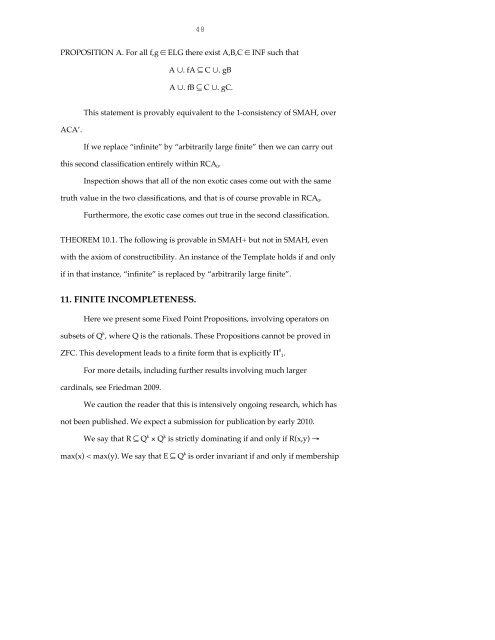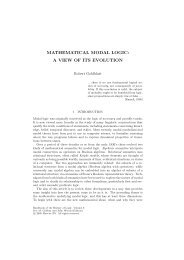my forty years on his shoulders - Department of Mathematics
my forty years on his shoulders - Department of Mathematics
my forty years on his shoulders - Department of Mathematics
- No tags were found...
You also want an ePaper? Increase the reach of your titles
YUMPU automatically turns print PDFs into web optimized ePapers that Google loves.
48PROPOSITION A. For all f,g ∈ ELG there exist A,B,C ∈ INF such thatA ∪. fA ⊆ C ∪. gBA ∪. fB ⊆ C ∪. gC.T<strong>his</strong> statement is provably equivalent to the 1-c<strong>on</strong>sistency <strong>of</strong> SMAH, overACA’.If we replace “infinite” by “arbitrarily large finite” then we can carry outt<strong>his</strong> sec<strong>on</strong>d classificati<strong>on</strong> entirely within RCA 0 .Inspecti<strong>on</strong> shows that all <strong>of</strong> the n<strong>on</strong> exotic cases come out with the sametruth value in the two classificati<strong>on</strong>s, and that is <strong>of</strong> course provable in RCA 0 .Furthermore, the exotic case comes out true in the sec<strong>on</strong>d classificati<strong>on</strong>.THEOREM 10.1. The following is provable in SMAH+ but not in SMAH, evenwith the axiom <strong>of</strong> c<strong>on</strong>structibility. An instance <strong>of</strong> the Template holds if and <strong>on</strong>lyif in that instance, “infinite” is replaced by “arbitrarily large finite”.11. FINITE INCOMPLETENESS.Here we present some Fixed Point Propositi<strong>on</strong>s, involving operators <strong>on</strong>subsets <strong>of</strong> Q k , where Q is the rati<strong>on</strong>als. These Propositi<strong>on</strong>s cannot be proved inZFC. T<strong>his</strong> development leads to a finite form that is explicitly Π 0 1.For more details, including further results involving much largercardinals, see Friedman 2009.We cauti<strong>on</strong> the reader that t<strong>his</strong> is intensively <strong>on</strong>going research, which hasnot been published. We expect a submissi<strong>on</strong> for publicati<strong>on</strong> by early 2010.We say that R ⊆ Q k × Q k is strictly dominating if and <strong>on</strong>ly if R(x,y) →max(x) < max(y). We say that E ⊆ Q k is order invariant if and <strong>on</strong>ly if membership
















